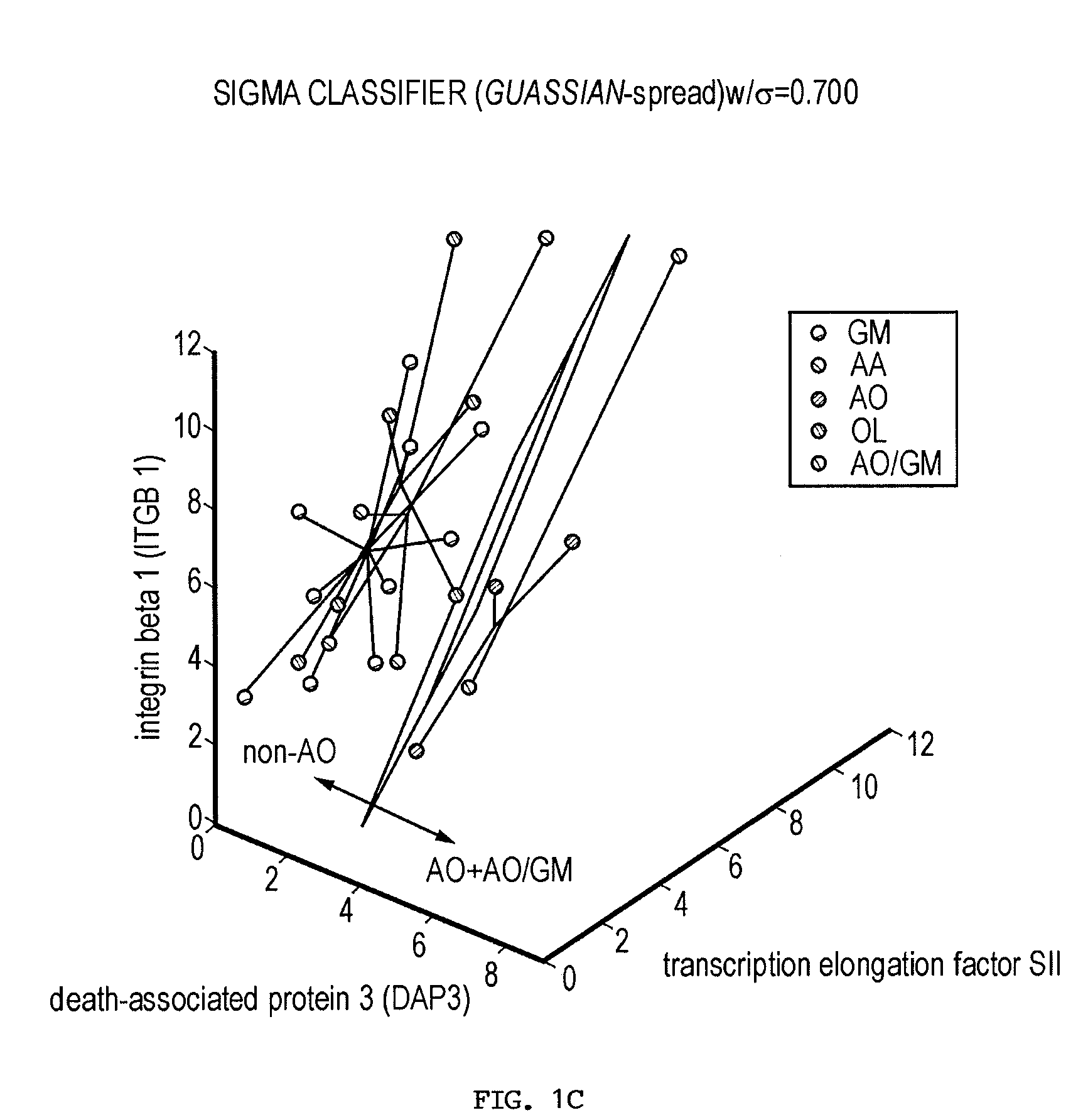Gene sets for glioma classification
a gene set and glioma technology, applied in the field of molecular biology and oncology, can solve the problems of small sample size, inability to apply the gene-based classification to gliomas, and limited number of human tissues for study, and the cost of such gene expression profiling projects
- Summary
- Abstract
- Description
- Claims
- Application Information
AI Technical Summary
Benefits of technology
Problems solved by technology
Method used
Image
Examples
example 1
Materials and Methods
[0231]Primary glioma tissues. All primary GM tissues were acquired from the Brain Tumor Center tissue bank of The University of Texas M. D. Anderson Cancer Center. The tumors were diagnosed according to two classifications: St. Anne-Mayo (Daumas-Duport et al., 1988) and the World Health Organization (Kleihues et al., 2000). Herein, gliomas are termed according to the St. Anne-Mayo nomenclature: low-grade OL, AO, AA, and GM. Tissue bank specimens were quick-frozen shortly after surgical removal and stored at −80° C. Hematoxylin-eosin (H&E)-stained frozen tissue sections are routinely prepared from all tissue bank specimens for screening. All tissue specimens for CDNA array analysis were screened by a neuropathologist (G.N.F.), and the diagnoses were independently confirmed by a second neuropathologist. The glioma tissue blocks were specifically selected for densest and purest tumor. All were comparatively and uniformly “pure” with minimal contamination by normal ...
example 2
Preliminary Results
[0239]Current glioma classifications are based on morphologic feature assessment and remain subjective and problematic. For example, among the 25 glioma cases in this study, two cases could be classified as either AO or GM depending on the morphologic criteria used, and are thus designated AO / GM. A primary goal of functional genomics is to identify key genes and gene combinations, small in number, that are potentially useful for diagnosis or as candidate therapeutic targets (Golub et al., 1999; Alizadeh et al., 2000; Bittner et al., 2000; Hedenfalk et al., 2001; Perou et al., 2000; Ben-Dor et al., 2000; Khan et al., 2001). A new algorithm (Kim et al., 2002) designed to find robust gene sets from small samples has been applied to the gene expression profile data derived from 25 human glioma surgical specimens. This algorithm builds classifiers from a probability distribution resulting from spreading the mass of the sample points to make the classification more diff...
example 3
Discussion
[0255]Gliomas are complex cancers whose classification relies upon morphologically based tumor classification schemes that are frequently subjective. Gene expression profiling provides a promising objective approach to method to classify such cancers. Thus, the issue remains as to how to identify the relevant genes that are closely linked to specific disease phenotypes.
[0256]The inventors used a novel method to find both strong classifiers and strong features. This method is briefly described in the Materials and Methods section and is explicated in more detail in (Kim et al., 2002). This algorithm considers the inherently variable or “high-noise” nature of microarray measurements and mimics this fuzziness by adding noise to the sample sets. The basic idea is that if the data are deliberately made “worse” and classifier genes can still be identified, then these genes are very likely to be robust.
[0257]Using this algorithm, the inventors identified robust classifier gene se...
PUM
| Property | Measurement | Unit |
|---|---|---|
| Volume | aaaaa | aaaaa |
| Fraction | aaaaa | aaaaa |
| Fraction | aaaaa | aaaaa |
Abstract
Description
Claims
Application Information
 Login to View More
Login to View More - R&D
- Intellectual Property
- Life Sciences
- Materials
- Tech Scout
- Unparalleled Data Quality
- Higher Quality Content
- 60% Fewer Hallucinations
Browse by: Latest US Patents, China's latest patents, Technical Efficacy Thesaurus, Application Domain, Technology Topic, Popular Technical Reports.
© 2025 PatSnap. All rights reserved.Legal|Privacy policy|Modern Slavery Act Transparency Statement|Sitemap|About US| Contact US: help@patsnap.com



